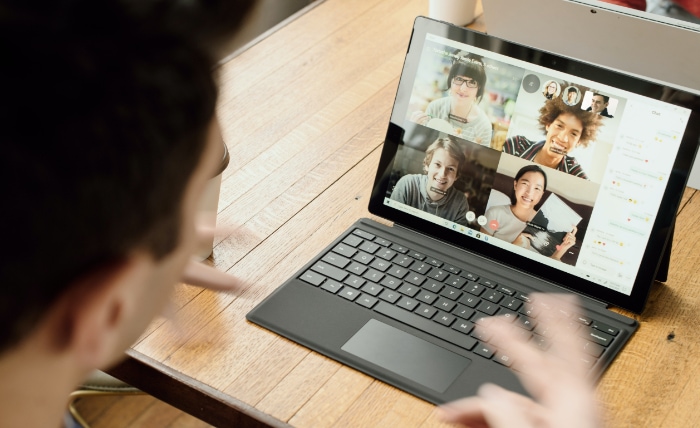Are You Monitored at Work? Here’s What to Look For

Workplace monitoring has long been a topic of discussion and debate among both employers and employees. As technology advances, the tools and methods companies use to keep an eye on their staff become increasingly sophisticated.
While many businesses argue that monitoring is essential to ensure productivity and security, employees often raise concerns about privacy and trust.
History and Evolution of Workplace Monitoring
The journey of workplace monitoring has its roots in the early days of structured employment, evolving significantly with the onset of technological advancements. Here, we explore its historical context, the tools used, and the shifts in monitoring techniques that have shaped the modern workplace.
From Punch Clocks to CCTVs
During the industrial revolution, the primary concern for employers was tracking time. The invention of the punch clock in the late 19th century allowed employers to monitor the hours an employee worked. This era was more about ensuring punctuality than monitoring performance.
Fast forward to the 20th century, with businesses growing in size and scale, security became a concern. Closed-circuit television cameras (CCTVs) became a common sight in workplaces, mainly for security purposes but also to oversee employee activity.
The Dawn of Digital Surveillance
As computers started becoming a staple in offices during the late 20th and early 21st century, the nature of monitoring began to change. Now, it wasn’t just about when an employee was working, but also how and what they were doing.
Software tools were developed to track keyboard strokes, monitor internet usage, and even capture screen activity.
Rise of the Remote Work Era
With the increasing shift to remote work, especially triggered by global events like the COVID-19 pandemic, a new set of monitoring tools emerged. Employers began using software to track not just work hours but also productivity metrics such as tasks completed, apps used, and websites visited.
The digital nature of remote work created an environment where almost every aspect of an employee’s workday could be quantified and analyzed.
Emergence of Advanced AI Tools
The most recent phase in workplace monitoring is characterized by the use of Artificial Intelligence (AI) and machine learning. These technologies can analyze vast amounts of data quickly, identifying patterns in employee behavior, efficiency metrics, and even predicting future performance or potential security breaches.
Balancing Act Between Productivity and Privacy
Throughout the evolution of workplace monitoring, there has been a tug of war between the need for businesses to ensure productivity and the rights of employees to privacy. The tools and techniques may have changed, but the fundamental debate remains: How much monitoring is too much, and where is the line between legitimate oversight and invasion of privacy?
Common Reasons Employers Monitor Employees

Workplace monitoring often evokes mixed reactions from employees. While some may view it as a necessary mechanism to ensure work quality, others might perceive it as an intrusion into their privacy.
To make sense of these practices, it’s essential to understand the motivations that drive employers to employ monitoring tools and techniques.
Enhancing Productivity
One of the primary reasons employers resort to monitoring is to boost productivity. By understanding how employees spend their time during work hours, employers can identify potential inefficiencies, distractions, or areas for training and development.
Tools that track website visits, for instance, can reveal if employees spend excessive time on non-work-related sites.
Safeguarding Company Information
Protecting sensitive company data is crucial in today’s digital age. Employers often monitor to prevent data breaches, unauthorized data sharing, or potential leaks.
This is especially critical in industries that handle sensitive customer data or proprietary information. Monitoring tools can alert IT departments to unusual file transfers or access requests, offering an additional layer of protection.
Compliance with Regulations
In certain industries, employers are required to maintain specific standards and practices to stay compliant with regulations. For instance, financial institutions might monitor communications to prevent insider trading.
In such cases, employee monitoring ensures that the company stays within the legal framework and avoids potential penalties.
Quality Assurance in Customer Interactions
Businesses that rely heavily on customer interactions, like call centers, often record calls or monitor employee-customer interactions. This isn’t just to keep tabs on the employee but also to ensure consistent quality in customer service.
These recordings can also be used as training material, helping new employees understand best practices.
Security Concerns
Beyond digital threats, physical security is also a concern for many businesses. Monitoring via CCTV cameras in offices, warehouses, or stores can deter theft, vandalism, or other security threats.
It also ensures that only authorized personnel access certain areas of a business establishment.
Balancing Trust and Responsibility
While there are legitimate reasons for employers to monitor employees, it’s also essential for businesses to foster an environment of trust. Open communication about why monitoring is in place, combined with clear policies, can help in striking a balance.
By understanding the reasons behind these practices, employees can better navigate their professional environment, and employers can ensure they’re using these tools responsibly.
Signs You Are Being Monitored
While workplace monitoring is often disclosed in company policies or employment contracts, not every instance of surveillance is overt. Whether due to uncertainty or discretion, there can be subtle indications that one’s activities at work are under observation.
Recognizing these signs can empower employees to take appropriate actions and maintain their privacy.
Increased IT Activities
Observing a spike in IT-related activities can sometimes hint at new monitoring measures. This could manifest as frequent software updates, the introduction of unfamiliar tools or platforms, or sudden, unexplained password changes.
If you notice IT teams taking an unusual interest in your workstation or computer, it might be a sign of enhanced monitoring.
Visible Cameras and Microphones
The presence of new cameras or microphones, especially in places that were previously devoid of such equipment, is an obvious sign. While these devices are often installed for security purposes, they can also be used to monitor employee behavior and interactions.
Browser Restrictions
If you suddenly find certain websites blocked or receive warnings when accessing specific content, it’s a sign that your internet activity is being monitored. Employers might restrict access to non-work-related sites to enhance productivity or prevent potential security risks.
Electronic Badge Access Records
Electronic badges not only grant access to buildings or specific rooms but also record entry and exit times. If your superiors or HR department frequently questions your comings and goings based on badge records, it indicates close monitoring of your physical presence.
Unusual Email Activities
Experiencing sudden return receipts, read notifications, or inquiries about specific email contents can signal email surveillance. Moreover, if emails you haven’t deleted start disappearing, it’s possible they’re being scrutinized or deemed inappropriate.
Questions About Personal Device Use
If your employer starts showing increased interest in your personal phone, tablet, or laptop usage while on company premises, it might mean there’s an ongoing effort to monitor devices connected to the company network.
Comments About Your Activities

When supervisors or managers mention details about your workday that they wouldn’t typically be aware of, it could be a result of monitoring. For example, if they reference specific websites you’ve visited or files you’ve accessed, it’s a clear indicator.
Software to Track Productivity
If you notice unfamiliar applications running in the background or find software that logs your activities, it’s a sign that your work is being closely monitored. These tools might track metrics like keystrokes, active minutes, and even idle time.
Sudden Policy Changes
The introduction of new or stricter monitoring policies without a clear explanation can be a subtle hint. While policy changes are a company’s prerogative, sudden alterations related to IT security or usage guidelines might suggest increased surveillance.
Recognizing the signs of monitoring helps employees to understand the extent of surveillance in their workplace. It’s always beneficial to be aware, ask questions when in doubt, and ensure one’s rights and privacy are respected.
Employee Rights and Legalities
The realm of workplace monitoring intersects with legal principles, primarily focusing on employee rights and privacy. While employers have legitimate reasons to monitor activities, there are boundaries and regulations that ensure employees are not unfairly or unlawfully surveilled.
Diving into these aspects can help both employers and employees navigate this sensitive area more effectively.
Understanding the Basis for Monitoring
Before any monitoring takes place, employers usually need to have a justified reason. Whether it’s for ensuring productivity, securing company data, or complying with specific industry regulations, the basis for monitoring needs to be grounded in genuine business concerns.
Consent and Awareness
In many jurisdictions, employers are required to inform their employees about any monitoring measures in place. This transparency often comes in the form of written policies or agreements.
While not always a legal requirement, obtaining explicit consent from employees before monitoring can prevent potential disputes.
Limits on Personal Data Collection
While monitoring tools can collect a vast array of data, there are typically legal restrictions on collecting personal or sensitive information. Employers are generally prohibited from diving into an employee’s personal life or accessing private communications without a valid reason.
Restrictions on Communication Surveillance
Monitoring employee communications, such as emails or phone calls, often comes with specific legal stipulations. In many regions, for instance, at least one party involved in the communication must be aware of and consent to the monitoring.
Some laws even mandate that both parties be informed.
Storage and Handling of Collected Data
When data is collected through monitoring tools, regulations often dictate how this information should be stored, for how long, and who can access it. Data protection laws, such as the General Data Protection Regulation (GDPR) in Europe, impose strict guidelines to ensure that personal data is handled responsibly.
Retaliation and Unlawful Termination
Employees have the right to express concerns or objections regarding monitoring practices. Legal frameworks in many regions protect employees from retaliatory actions or unlawful termination based on their stance on surveillance issues.
Right to Access and Correction
In regions with robust data protection laws, employees have the right to access data collected about them. They can often request corrections if they find inaccuracies in this data.
Employers are typically obligated to accommodate these requests within reasonable timeframes.
Awareness of rights and legalities is crucial in the modern workplace. While employers have responsibilities to their business objectives and stakeholders, they must also respect the rights and dignity of their employees.
By understanding these intricacies, a balance can be struck that meets the needs of all parties involved.
What to Do If You Believe You’re Being Monitored

Discovering or even just suspecting that you’re being monitored at work can evoke a range of emotions, from discomfort to anxiety. While the first instinct might be to panic or confront, it’s essential to approach the situation rationally and informatively.
Here’s a guide on how to handle the situation if you believe you’re under surveillance.
Gather Evidence
Before making any claims or confronting your superiors, it’s crucial to have evidence that supports your suspicions. This could include screenshots of unfamiliar software running on your computer, noticing unusual behavior in your communication tools, or spotting newly installed cameras or microphones.
Review Company Policies
Most companies have specific policies regarding workplace monitoring. It’s worthwhile to go over your employment contract, staff handbook, or any other documentation that might shed light on the company’s monitoring practices.
This will give you a clearer understanding of what’s permitted and what might be an overreach.
Discuss with Colleagues
Confiding in trusted colleagues can help in multiple ways. They might have noticed the same signs or can provide insights you might have missed.
Sharing experiences can help validate your concerns and offer a collective approach if needed.
Approach Human Resources
The HR department is there to address employee concerns. If you believe your privacy is being compromised, schedule a meeting with HR. They can provide clarity on company policies, the extent of monitoring, and the reasons behind any surveillance.
Protect Personal Information
If you’re concerned about monitoring, especially digital surveillance, take steps to protect your personal information. Avoid accessing personal emails or sensitive sites from work devices, and consider using encryption tools or virtual private networks (VPNs) if allowed.
Seek External Advice
If your concerns persist or if you believe the monitoring is invasive and breaches your rights, consider seeking advice from legal professionals or workers’ unions. They can offer guidance on the next steps and inform you about your rights.
Open Dialogue with Management
A direct conversation with your superiors can sometimes clear up misunderstandings. They might provide reasons for the monitoring, which could be grounded in genuine business or security concerns. An open dialogue can also pave the way for more transparency in the future.
Stay Professional
Regardless of your concerns, it’s essential to remain professional. Avoid making accusations without evidence, and ensure that your work performance doesn’t suffer. Your professionalism will lend more credibility to your claims or concerns.
Conclusion
Workplace monitoring presents a delicate balance between business needs and individual rights. With the rapid advancement of technology, these practices will continue to evolve, making it imperative for both employees and employers to stay informed.
By understanding the signs, knowing one’s rights, and maintaining open communication, a harmonious professional environment can be maintained, ensuring mutual respect and understanding between all parties.


